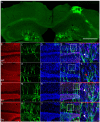Apolipoprotein E regulates the maturation of injury-induced adult-born hippocampal neurons following traumatic brain injury
- PMID: 32119690
- PMCID: PMC7051085
- DOI: 10.1371/journal.pone.0229240
Apolipoprotein E regulates the maturation of injury-induced adult-born hippocampal neurons following traumatic brain injury
Abstract
Various brain injuries lead to the activation of adult neural stem/progenitor cells in the mammalian hippocampus. Subsequent injury-induced neurogenesis appears to be essential for at least some aspects of the innate recovery in cognitive function observed following traumatic brain injury (TBI). It has previously been established that Apolipoprotein E (ApoE) plays a regulatory role in adult hippocampal neurogenesis, which is of particular interest as the presence of the human ApoE isoform ApoE4 leads to significant risk for the development of late-onset Alzheimer's disease, where impaired neurogenesis has been linked with disease progression. Moreover, genetically modified mice lacking ApoE or expressing the ApoE4 human isoform have been shown to impair adult hippocampal neurogenesis under normal conditions. Here, we investigate how controlled cortical impact (CCI) injury affects dentate gyrus development using hippocampal stereotactic injections of GFP-expressing retroviruses in wild-type (WT), ApoE-deficient and humanized (ApoE3 and ApoE4) mice. Infected adult-born hippocampal neurons were morphologically analyzed once fully mature, revealing significant attenuation of dendritic complexity and spine density in mice lacking ApoE or expressing the human ApoE4 allele, which may help inform how ApoE influences neurological diseases where neurogenesis is defective.
Conflict of interest statement
The authors have declared that no competing interests exist.
Figures



References
-
- Dewan MC, Rattani A, Gupta S, Baticulon RE, Hung YC, Punchak M, et al. Estimating the global incidence of traumatic brain injury. J Neurosurg. 2018:1–18. - PubMed
Publication types
MeSH terms
Substances
Grants and funding
LinkOut - more resources
Full Text Sources
Other Literature Sources
Medical
Molecular Biology Databases
Miscellaneous

